|
80x5 -
240x3 -
240x4 -
320x1 -
320x2 -
320x3 -
640x1 -
640x2
Set display option above.
Click on
images to enlarge. |
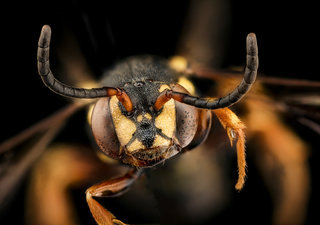
© Copyright source/photographer
· 7
Nomada graenicheri, face, f, Ritchie, WV |
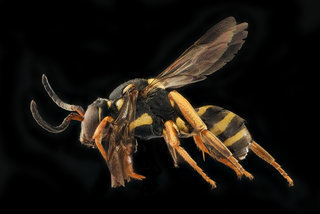
© Copyright source/photographer
· 7
Nomada graenicheri, left, f, Ritchie, WV |
|
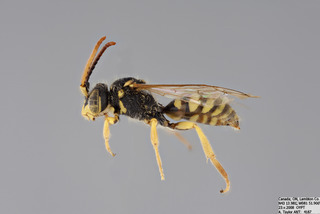
© Copyright Laurence Packer 2014
· 7
Nomada graenicheri MALE mm |
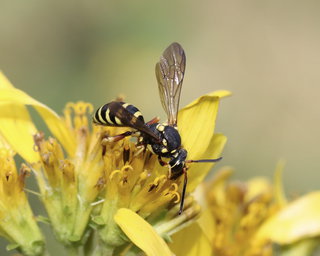
Michael Veit · 6
Nomada graenicheri, f on Heliops -- |
|
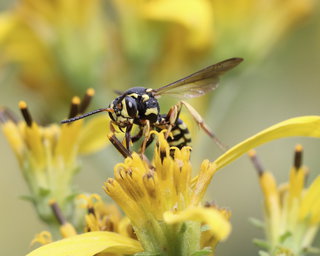
Michael Veit · 6
Nomada graenicheri, f on Heliops -- |
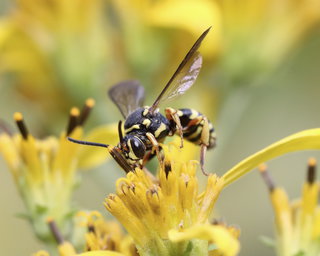
Michael Veit · 6
Nomada graenicheri, f on Heliops -- |
|
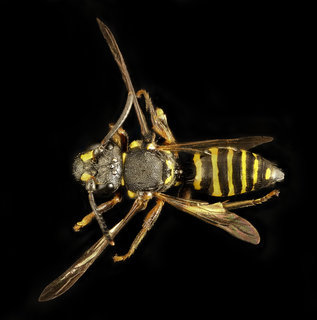
© Copyright source/photographer
· 5
Nomada graenicheri, m, back, Minnesota |
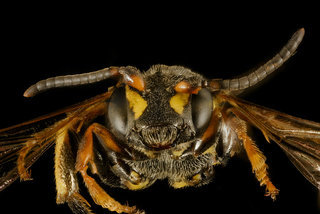
© Copyright source/photographer
· 5
Nomada graenicheri, m, face, Minnesota |
|
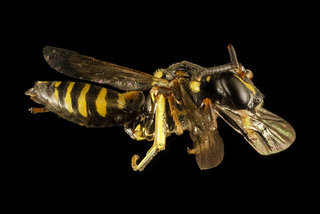
© Copyright source/photographer
· 5
Nomada graenicheri, m, side, Minnesota |
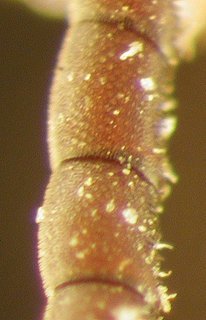
© Mary Paul
· 1
Nomada graenicheri, female, antennae 6 and 7 |
|
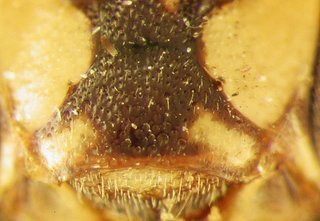
© Mary Paul
· 1
Nomada graenicheri, female, clypeus |
|
Overview |
Unpublished synonymy with Nomada besseyi - Sam Droege looked at Cockerell's N. graenicheri holotype at the Smithsonian. A point-by-point comparison with Broemeling and Moalif's 1988 revision paper found that their description of Nomada besseyi matched the N. graenicheri type with the following minor exceptions: Supraclypeus with 2 small yellow submedian dots (this apparent in other eastern specimens too).
Clypeus had yellow on the far sides along the rim, the remainder black....though this may be what Broemeling and Moalif meant by "median band."
Broemeling and Moalif mentioned that the wing was "brown with pale subapical area" but I would have to say that the type has only lightly
infuscated wings and can't see any particular pale areas towards the tips.
The key character for this species is the lack of long pubescence on the rear face of the propodeum, which is unlike almost all other Nomada (There may be one other species, but it can't be recalled as this account was written) and the type certainly lacks hair. It is clear that they are the same species and that N. graenicheri would have precedence over N. besseyi. Another very useful identification tip is the presence of uniform, thin yellow bands, about one third or less the longitudinal width of the segments that transverse the entire segment, these yellow lines approximately equal in size, shape and placement across T1-T4.
T5, at least at times is divided into 2 lateral patches of yellow and one central band of yellow rather than one continuous band
Reprinted with permission from: Mitchell, T.B. 1962 Bees of the Eastern United States. North Carolina Agricultural Experiment Station Technical Bulletin No. 152.
FEMALE�Length 10 mm.; mandibles simple; coxae not spined; punctures in general fine and close, densely crowded on face above antennae, more distinct but close below and on clypeus, some shining spaces on cheeks below; scutum densely and rather finely rugoso-punctate, crowded on pleura above, becoming slightly separated and coarser below; scutellum deeply grooved; propodeum dull, a few punctures on each side of triangle; abdominal terga densely and minutely punctate, only the very narrow apical rims being impunctate on terga 2-4, tergum 1 with a subapical black band which is more distinctly and sparsely punctate; color black except for yellow areas as follows; a pair of apical spots on each side of clypeus, lateral areas between clypeus and eyes, extending more narrowly along orbits to top of eyes, a very narrow line along upper half of posterior orbits, collar, tubercles, tegulae, transverse band on pleura below, a pair of large spots on scutellum and a band on metanotum, compete but narrow transverse bands on abdominal terga 1-5, and on sterna 2 and 3, a median blotch on 4; all coxae yellow in part, the femora dark below, yellowish to ferruginous above, front and mid tibiae and tarsi largely ferruginous, hind tibiae largely yellow, darkened on inner and outer surfaces apically, the basitarsus piceous, apical joints more reddish.
DISTRIBUTION�Wisconsin.
|
|
|
Identification | |
Extracted from: Cockerell, T.D.A. (1905). Some bees of the Genus Nomada from Wisconsin. The Canadian Entomologist pp. 189 - 191.
Length, about 10.5 mm.; black,
with bright lemon-yellow markings, the only red is on base of antennae,
legs, :md a little on mandibles; mandibles simple; anterior coxae without
spines; basal nervure meeting trans verso-medial ; third antennal joint
slightly longer than fourth. This is a Xanthidium with the face black in
the middle and with yellow lateral marks, like the European N. succincta.
It has the strongest possible superficial resemblance to N. modesta, but in
addition to the absence of spines on the coxre, it differs thus: labrum
dark, with a transverse yellow spot anteriorly; clypeus with a yellow mark
011 each side, pointed mesade suprclypeal area with two minute yellow
spots; lateral face marks extending nearly to summits of eyes, obliquely
truncate at end. and concave opposite the antennce; mesothorax
dull, cousely but extremely closely punctured; metathorax wholly
black; legs with a good deal of yellow, anterior and hind coare marked
with yellow, the later copiollsly; all the femora behind, and the anterior
and hind tibiae behind, strongly blackened; all the tibiae with yellow, the
hind ones largely yellow, ill front with a black spot, shading above into a
rufous cloud, on the apical half; basal joint of hind tarsi dark, practically
black on outer side, with a short yellow stripe posteriorly; abdomen
narrower, and not so shiny; venter with broad yellow bands on the second
and third segments, and a good deal of yellow on the third. The first
three joints of the antennae are mainly red, the rest black; posterior orbits
with a narrow yellow stripe; upper border of prothorax, tubercles, transverse mark on pleura, two large spots on scutellum, and a stripe on postsClltellum, as well as five continuous bands on abdorllen, all yellow.
Tegule largely yellow; wings dusky, stigma dark ferruginous, nervures
fuscous.
|
|
|
Names | |
|
|
| Supported by | |
Updated: 2024-04-23 21:14:50 gmt
|